
| Version | Summary | Created by | Modification | Content Size | Created at | Operation |
|---|---|---|---|---|---|---|
| 1 | Miaomiao KANG | -- | 6211 | 2022-09-14 04:51:09 | | | |
| 2 | Miaomiao KANG | + 22 word(s) | 4395 | 2022-09-21 04:33:35 | | |
Video Upload Options
Photodynamic therapy (PDT) is emerging as a minimally invasive therapeutic modality with precise controllability and high spatiotemporal accuracy in the field of diseases treatment. PDT mainly relies on the photosensitizers (PSs) to generate oxidative reactive oxygen species (ROS), to play the therapeutic role. Type I photosensitizers, that undergo hydrogen atom abstraction or electron transfer manner and subsequently produce superoxide radical (O2•−), hydroxyl radical (OH•), or hydrogen peroxide (H2O2), etc., is showing more and more prominent advantages, particularly in hypoxic tissues, since type I PSs-involved PDT usually exhibit distinctive hypoxia tolerance. Regarding the diverse type I PSs, aggregation-induced emission (AIE)-active type I PSs are currently arousing great research interest owing to their distinguished aggregation-induced emission and aggregation-induced generation of reactive oxygen species (AIE-ROS) features.
1. Introduction
2. Basic Principles of Type I PDT
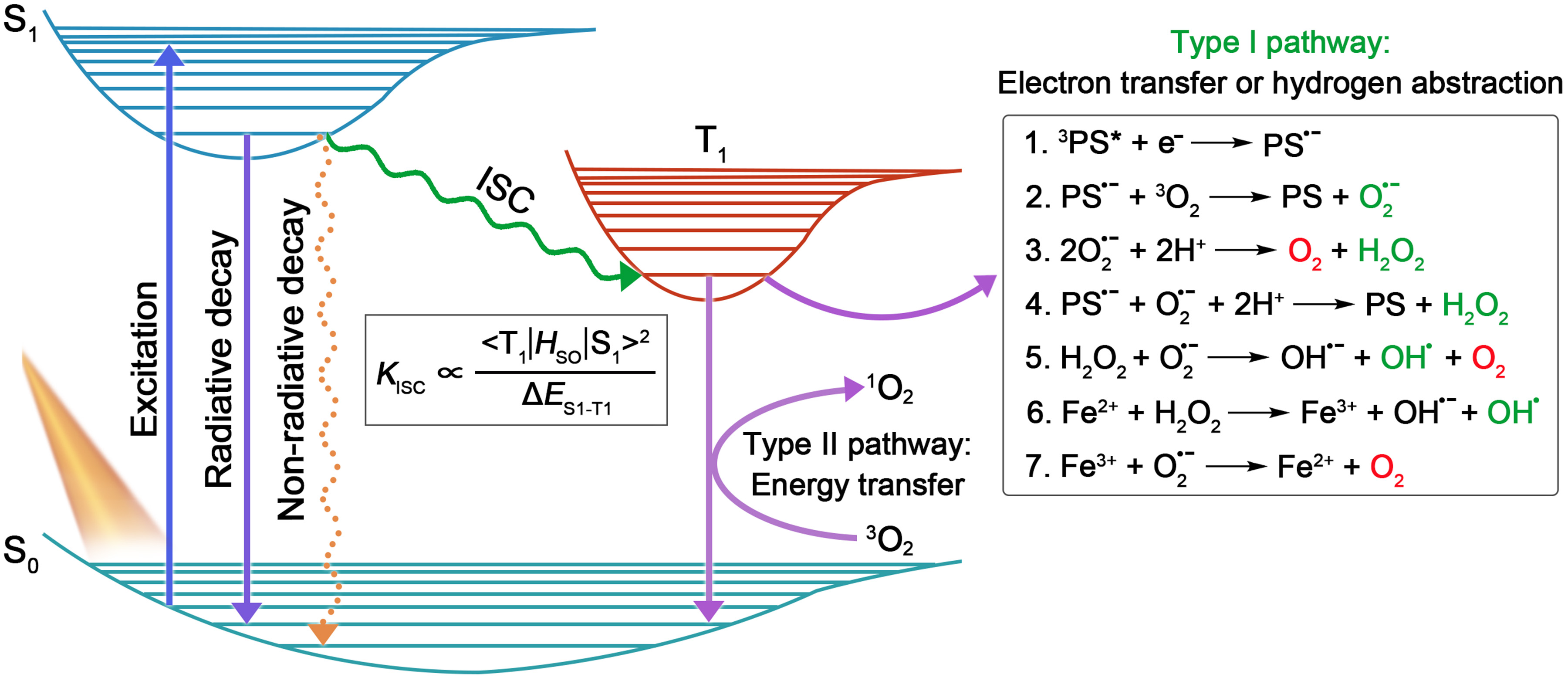
3. Applications of Type I AIE PSs
3.1. The Anti-Tumor Applications
For the purpose of redshifted absorption and emission wavelengths, as well as boosted theranostic performance, AIE PSs and other organic PSs are generally engineered to contain multiple aromatic rings and/or large conjugated units in their molecular structures, giving rise to their high hydrophobicity. In order to facilitate the in vivo biological applications, hydrophobic AIE PSs are commonly encapsulated within nanovehicles based on amphiphilic biocompatible matrices to form well-dispersed AIE nanoparticles (NPs) in aqueous physiological environments [48]. Additionally, bright fluorescence, excellent ROS production and enhanced permeability and retention (EPR) effect-driven tumor location can be successfully achieved, simultaneously, after nanofabrication, since the aggregation of AIE PSs within the intraparticle limited room is capable of effectively astricting their active intramolecular motions, thus, blocking nonradiative thermal dissipation and saving the excited state energy for the fluorescence and ISC pathway [28,31]. In addition to passively targeted tumor enrichment by the EPR effect, actively targeting transport of AIE PSs favored by specific recognition will be able to further enhance PDT efficacy. From those, Lou et al. [49] developed an amphiphilic polymeric matrix with conjugated targeting peptides to co-assemble with a type I AIE PS of TTB to fabricate tumor-specific targeting TTB NPs for amplifying type I photodynamic cancer treatment. In addition, Duo et al. [50] put forward an innovative protocol for efficiently targeted delivery of type I AIE PSs to tumor tissues by taking full advantage of the hypoxia condition in solid tumors and selective hypoxia tropism of some bacteria. For this approach, a novel bacteria-based AIE hybrid system was built, enabling the powerful delivery of type I AIE PS of TBP-2 into the hypoxic tumor microenvironments for hypoxia-tolerant PDT of orthotopic colon cancer.
Considering that the effective killing range of ROS is typically confined to the immediate vicinity of PSs on a subcellular scale, an appropriate organelle-targeting location of PSs is, therefore, highly desired for implementing final PDT outcomes. Different subcellular organelles play their own unique roles in maintaining the normal physiological function of cells. It has been acknowledged that the organelles, including cell membrane, mitochondria, lysosomes, ER, and nucleus, are all valid sites for performing PDT [51]. To date, diverse subcellular organelle-targeted type I AIE PSs-based anti-tumor systems have been exploited in succession [52]. For instance, Feng et al. [53] developed a class of cationic AIE PSs possessing a specific tumor cell mitochondrial targeting feature to facilitate both type I and type II PDT. In addition, Tang et al. [54] proposed a useful molecular design guideline for constructing efficient AIE PSs and tailoring their organelle specificity.
Among the various subcellular organelles, of particular importance is the cell nucleus as it dominates the cellular gene expression, metabolism and proliferation [55]. Moreover, the DNA and RNA parts of the nuclei are very sensitive to type I ROS due to its extremely high chemical reactivity [56]. In view of this, Wang et al. [56] explored, for the first time, a nucleus-targeting PDT strategy based on type I AIE PSs, by making full use of theranostic agents and nanocarrier systems (Figure 2a). Two AIE PSs, named TFMN and TTFMN, with typical D–A structures and sufficient molecular rotors, were firstly designed and synthesized. Compared with TFMN, TTFMN was equipped with additional TPE moiety in structure, which endowed it with much better AIE peculiarity. Various ROS indicators were employed to distinguish the ROS species produced by TFMN and TTFMN, through fluorescence spectroscopy and ESR measurements, which was discriminated to type I ROS of OH•. Moreover, the TTFMN showed stronger ESR signal intensity than TFMN (Figure 2b), indicating its better generation capacity of OH•, which was attributed to its superior AIE tendency and smaller ΔES1–T1. With the help of a lysosomal acid-activated nuclear localization signal peptide (TAT)-modified amphiphilic polymer, the resultant TTFMN-loaded NPs (TTFMN-NPs) exhibited nucleus-anchoring delivery ability, visualized by the intrinsic fluorescence property of TTFMN (Figure 2c). Further in vivo investigations uncovered that TTFMN-NPs with good biosecurity and long blood circulation time could specifically accumulate at tumor sites (Figure 2d). Upon white light irradiation, TTFMN-NPs induced high-efficiency tumoricidal results with a 75.1% tumor growth inhibition rate (Figure 2e,f). This work offered a new perspective in the construction of type I PS-based and nucleus-targeted nanotheranostic systems.
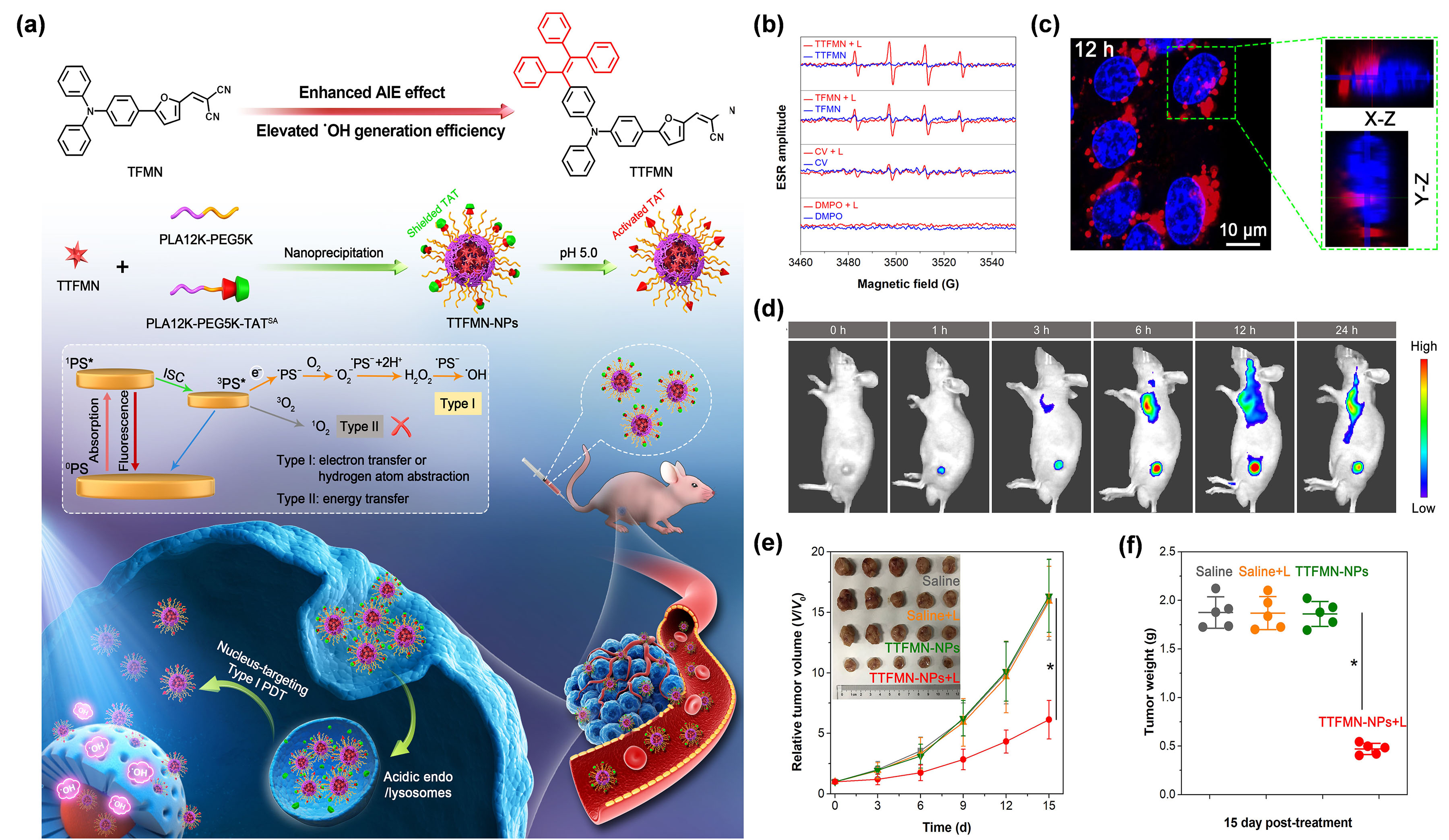
Figure 2. (a) Illustration of molecular design principle, nanotheranostics fabrication, and its application in nucleus-targeted type I photodynamic cancer treatment. (b) ESR analysis for OH• generation of TTFMN and TFMN after white light irradiation (200 mW/cm2). (c) CLSM images of nuclear targeting delivery of TTFMN-NPs (2 µg/mL TTFMN) after incubation with 4T1 cells for 12 h. The blue color represents the fluorescence of Hoechst 33342 for locating cell nucleus and the red color represents the fluorescence of TTFMN-NPs. (d) Time-dependent in vivo FLI of tumor-bearing mice after injection with TTFMN-NPs. (e) The growth curves of tumors in different treatment groups (n = 5, *p < 0.001). (f) The tumor weights of mice after treatments for 15 days (n = 5, * p < 0.001). Reprinted with permission from [56], copyright 2021, Wiley-VCH.
At present, most AIE PSs can only be effectively excited by short wavelength of UV or visible lights. However, the shallow penetration depth of the excited light presented a major scientific challenge for AIE PSs to treat deep-seated tumors. Based on this, the combination of rare earth doped upconversion NPs (UCNPs) would provide an effective solution to this problem, since UCNPs can serve as a near-infrared (NIR) light transducer to harness and convert the NIR laser to UV-visible light, enabling the construction of robust NIR laser excitable nanotheranostic systems [57]. Encouraged by the synergistic effect of combining UCNPs and AIE PSs toward cancer therapy, Wang et al. [58] creatively designed and developed a triple-jump photodynamic nanotheranostic agent, termed MUM NPs, by integrating a type I AIE PS of MeOTTI into the multifunctional nanoplatform built by UCNPs and manganese dioxide (MnO2), for enhanced theranostic outputs in PDT (Figure 3a). Specifically, MeOTTI was engineered to afford the type I ROS capacity verified by the ESR test (Figure 3b). With the aid of UCNPs whose emission spectrum matched well with the absorption spectrum of MeOTTI, the resulting Förster resonance energy transfer (FRET) effect between UCNPs and MeOTTI not only achieved the excitation light extension from UV-visible to NIR region, but also significantly elevated the ROS generation efficiency (Figure 3c). Attractively, the introduction of the MnO2 component was aimed at depleting the intracellularly upregulated glutathione (GSH), thus, significantly facilitating the production of highly oxidative type I ROS in cells. Meanwhile, the yielded Mn2+ was also able to catalyze the intracellular H2O2 to generate OH•, as well as for magnetic resonance imaging (MRI). Therefore, the triple-jump type I ROS generation of MUM NPs could be smoothly achieved inside the tumor cells after NIR laser irradiation. This splendid triple-jump photodynamic theranostic protocol was confirmed by a series of cell and animal experiments (Figure 3d,e).
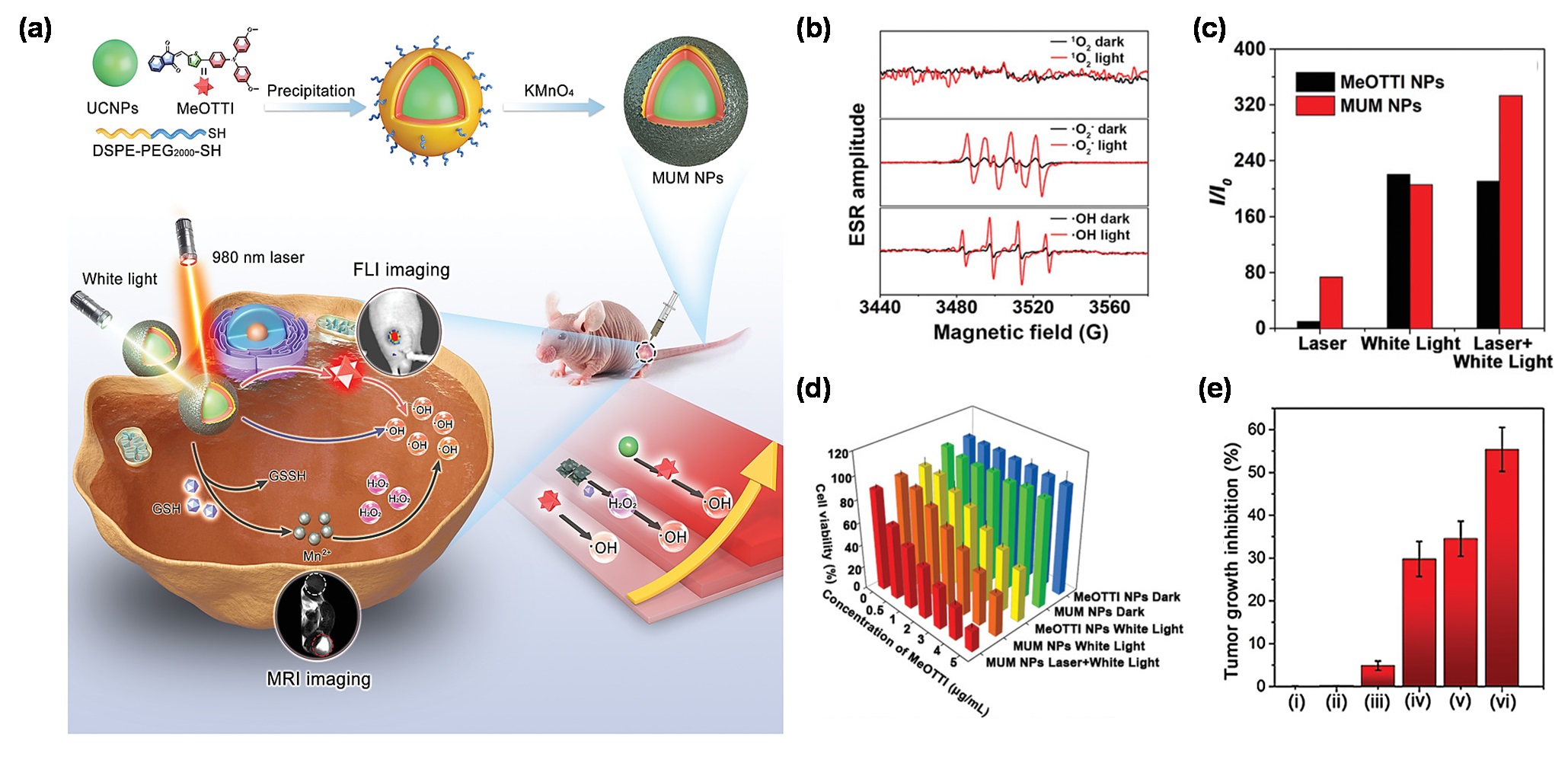
Figure 3. (a) Chemical structure of MeOTTI and schematic illustration of triple-jump photodynamic theranostic protocol. (b) ROS generation type of MeOTTI determined by ESR test. (c) ROS production efficiency of MeOTTI NPs and MUM NPs at the same MeOTTI concentration under the irradiation of different light sources. (d) Cell viability of 4T1 cells treated with different conditions. (e) Tumor inhibition ratios of mice after different treatments, namely: (i) PBS, (ii) MUM NPs, (iii) 980 nm laser and white light, (iv) MeOTTI NPs and white light, (v) MUM NPs and white light, (vi) MUM NPs, 980 nm laser and white light (n = 5, * p < 0.001). Reprinted with permission from [58], copyright 2021, Wiley-VCH.
In addition to being assisted by UCNPs, exploring AIE PSs with an outstanding two-photon absorption property was another effective method to break through the obstacles encountered by short-wavelength excitation [59]. Moreover, AIE PSs have proved to be promising candidates for developing two-photon excitable PDT agents, as the two-photon absorption cross section (δ2PA) of AIE PSs could obviously be raised by simply increasing their loading amount in the NPs, exhibiting a unique aggregation-enhanced nonlinear optical effect [60]. Generally, the wavelength in two-photon excitation is twice as long as that of one-photon absorption, thus, making the NIR light-excitable photodynamic theranostics feasible. In this regard, Tang et al. [61] constructed amphiphilic lipids-enveloping AIE NPs by encapsulating a tactfully designed two-photon excitable type I AIE PS (TPE-PTB) (Figure 4a). With strong D–A interaction and effective π-conjugation strength, TPE-PTB-formed NPs resulted in a high δ2PA of 560 GM under 800 nm two-photon laser irradiation (Figure 4b). Moreover, TPE-PTB NPs exhibited a far-red fluorescence emission with a high quantum yield of 23%. These advantageous superiorities enabled TPE-PTB NPs to image deep-seated tumors and vessels with a high spatial resolution on a mouse melanoma model. Notably, type I ROS species of OH• could be effectively generated by AIE NPs under 800 nm laser illumination (Figure 4c). Further mechanistic explanation showed that TPE-PTB could take one electron from an environmental hydroxyl anion to form anionic PS, for a subsequent series of photochemical reactions, to eventually generate OH• (Figure 4d). As shown in Figure 4e, a live–dead staining experiment showed that TPE-PTB NPs plus NIR laser irradiation could cause more than 90% cell death rate as analyzed by flow cytometry, while no obvious cell death was found in other control groups. More importantly, TPE-PTB NPs performed well for in vivo FLI-guided type I two-photon PDT, with significant inhibition of tumor growth (Figure 4f). In addition, TPE-PTB was able to be effectively cleared from the mouse body after completing the treatment, guaranteeing favorable in vivo biosecurity. A potent NIR-excited type I PDT nanoplatform based on AIEgens was successfully constructed in this work.
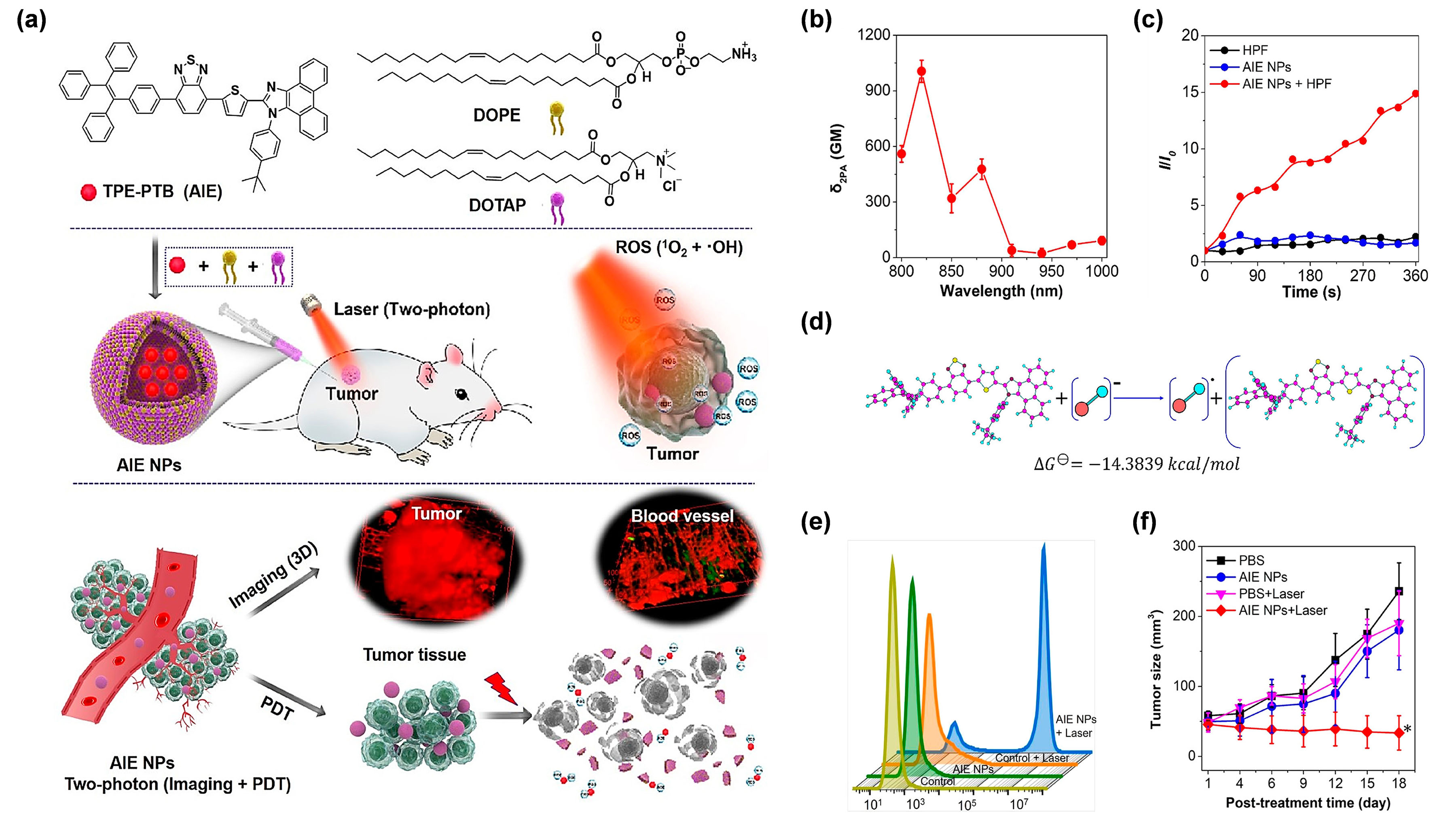
Figure 4. (a) Chemical structure of TPE-PTB and illustration of two-photon-excited FLI-guided PDT applications. (b) δ2PA of the TPE-PTB NPs under different excitation wavelengths. (c) OH• production ability of TPE-PTB NPs indicated by HPF. (d) Mechanism and calculation of OH• generation analysis. (e) Flow cytometry of A375 cells stained by PI after treatment with different conditions. (f) Tumor growth curves of mice in different treatments. (* p < 0.05). Reprinted with permission from [61], copyright 2020, American Chemical Society.
3.2. The Antimicrobial Applications
Infectious diseases caused by pathogenic microbes including bacteria, fungi, and viruses, pose serious threats to humans, since they usually cause severe diseases such as foodborne illness, tuberculosis, sepsis, meningitis, and pneumonia, for which the situation continues to worsen, along with the appearance of antibiotics-resistant microbes [62,63]. In view of this rigorous challenge, PDT has stood out as a promising candidate for antimicrobial applications including the inactivation of multidrug resistant (MDR) microbe species; ROS could provide an aggressive attack on microbes without the need for complete entrance of PSs into the microbial interior, which can potentially avoid the generation of microbial resistance [64]. In this respect, type I PDT has been widely employed due to the longer half-life of O2•−, as well as the strong oxidizing property of OH•. Possessing the advantage of AIE and AIG-ROS, periodical achievements in the FLI-guided PDT of pathogenic microbes have been attained, based on AIE-active type I PSs [65,66,67].
For example, Wang et al. [68] reprepared a functional nanofibrous membrane (TTVB@NM) by doping a type I AIE PSs TTVB in an electroactive polymer (PVDF-HFP) matrix using the electrospinning technique, and achieved the photodynamic elimination of pathogenic droplets and aerosols under sunlight (Figure 5a). Due to the inherent positive charge, TTVB was able to effectively stain several kinds of bacteria and fungi (Figure 5b). Under sunlight irradiation, TTVB possessed outstanding type I ROS generation efficiency (Figure 5c–e), owing to its typical D–A structure and electron-rich heteroatoms (S and N). After doping into the PVDF-HFP, the obtained nanofibrous membrane (TTVB@NM) was demonstrated to exhibit similar photophysical performances as TTVB, as well as favorable washability and photostability, indicating great potential for effective antimicrobial effect. The antimicrobial activity of TTVB@NM was subsequently verified by the significantly decreased survival rates of four kinds of pathogenic droplets (Gram-positive bacteria S. aureus, Gram-negative bacteria E. coli, fungi C. albicans, and M13 bacteriophage) after 1 h under sunlight irradiation (Figure 5f). Further evaluation of the antimicrobial effect of TTVB@NM against pathogenic aerosols was carried out by placing the pathogenic aerosols-loaded TTVB@NM outdoors (Figure 5g). The results revealed that TTVB@NM could effectively inactivate pathogenic aerosols containing bacteria (inhibition rate: > 99%), fungi (~88%), and viruses (>99%) within only 10 min under sunlight irradiation (Figure 5h,i). The author also stated that TTVB was measured to show moderate photothermal conversion performance, which could play an adjuvant role for microbe inhibition.
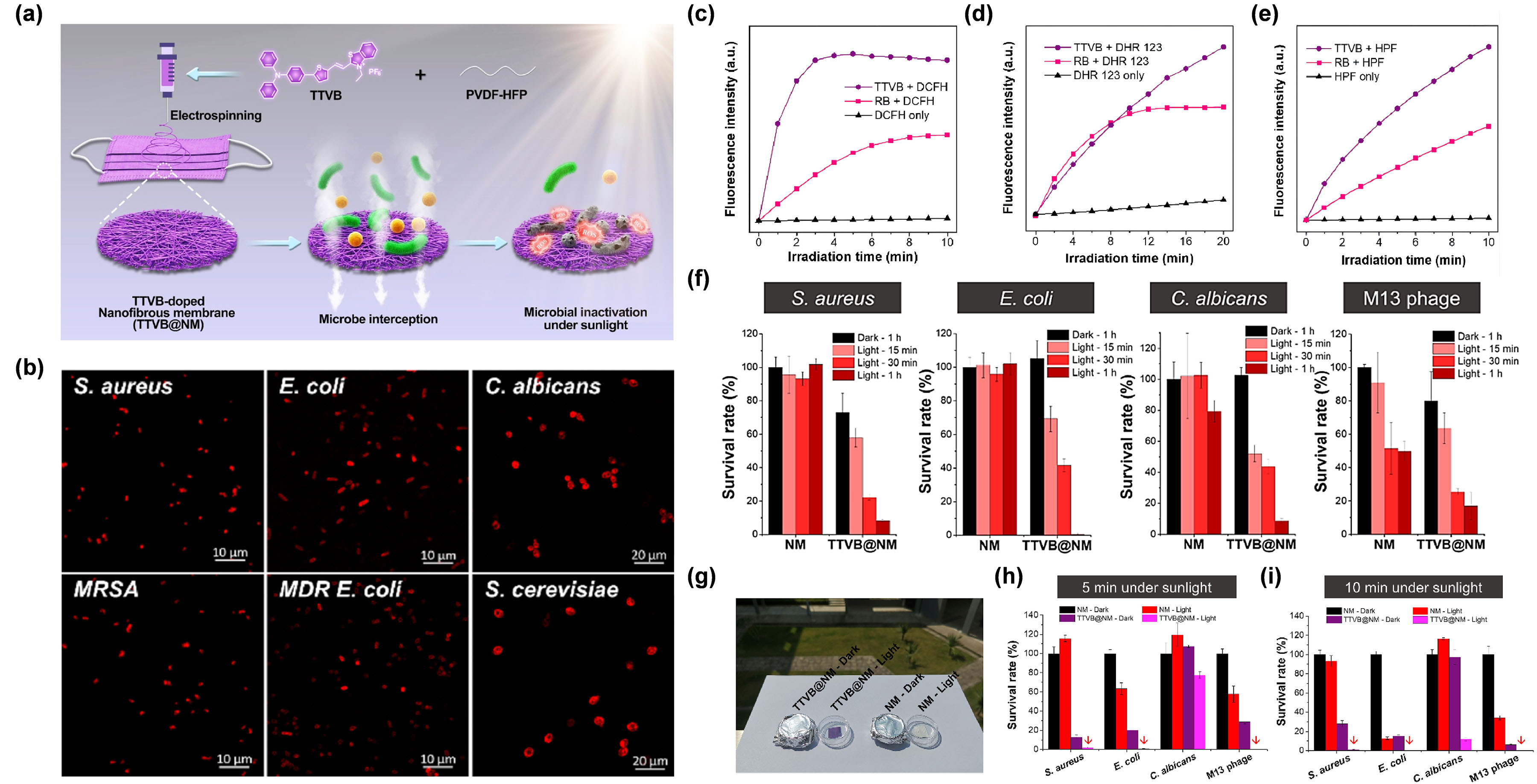
Figure 5. (a) Diagram of the preparation of TTVB@NM for antimicrobial applications. (b) CLSM imaging of bacteria and fungi co-incubated with TTVB. Relative fluorescence intensity of (c) DCFH for total ROS detection, (d) DHR123 for O2•− detection, and (e) HPF for OH• detection of TTVB and RB under light irradiation (34 mW/cm2). (f) Microbial survival rate treated with NM or TTVB@NM in dark or under sunlight irradiation. (g) Antimicrobial experiment against pathogenic aerosols in dark or under sunlight irradiation. Survival rate of microbes under sunlight irradiation for (h) 5 min and (i) 10 min. Reprinted with permission from [68], copyright 2021, Elsevier.
3.3. The Inhibition of Harmful Algal Bloom
Harmful algal bloom (HAB) has become a global environmental problem, causing serious impact on aquatic ecology and economy [69]. The rapid growth of algae aggravates O2 depletion and the release of harmful toxins, consequently threatening the survival of aquatic animals, resulting in widespread freshwater and marine area pollution [70]. Although many physical and chemical methods have been developed to inhibit HAB, their inherent drawbacks, such as low suppression rate, limited application area, and the possibility of secondary and persistent pollution, have hindered their widespread application [71]. In recent years, ROS-generating algaecides have aroused extensive interest owing to their effective, eco-friendly and cost-efficient properties [72]. Therefore, exploring PSs which show excellent elimination effect of algae upon light irradiation without causing toxicity to other aquatic organisms, will be a promising strategy. Of particular interest are the type I AIE PSs, which can exhibit excellent ROS generation ability under low O2 concentration, suitable for the relatively low O2 environment of algal bloom.
Under this circumstance, Luo et al. [73] developed a water-soluble type I AIE PS with self-degrading ability, termed TVP-A, which could selectively eliminate HAB upon exposure to natural light (Figure 6a). TVP-A was constructed with a typical D–A structure with a primary amino group modified onto the terminal pyridinium, endowing the molecule with good water solubility. Moreover, the positively charged property also endowed TVP-A with a specific algae-targeting feature, on account of the negatively charged cell membrane of the algae. Upon white light irradiation, TVP-A exhibited superb ROS generation ability through both type I and type II mechanisms, particularly ·OH. In this work, they co-incubated one cyanobacteria (M. aeruginosa) and two freshwater green algae (C. vulgaris, and C. reinhardtii) with TVP-A at different concentrations, respectively, under 16 h light (50 μEinstein/m2/s1)/8 h dark cycles to explore the effective concentrations in controlling the HAB. It was found that the 50% effective concentration (EC50) value of TVP-A was less than 1 ppm for these three kinds of algae (Figure 6b). As shown in Figure 6c, in contrast with the commercial algaecide (Alg), which still had a large amount of algae residue when the concentration was as high as 100 ppm, TVP-A exhibited ultra-efficient control of HAB, with effective inhibition of the algae bloom C. reinhardtii at 5 ppm and a clear color of water after five natural daily cycles at 10 ppm. The fluorescence change of chlorophyll in C. reinhardtii was measured to prove the irreversible damage of chloroplast due to the photodynamic process (Figure 6d). After 2 h of illumination, the fluorescence intensity of chlorophyll decreased to less than 20%, indicating that TVP-A could rapidly cause irreversible damage to these important organelles of algal cells, at especially low concentration, upon illumination. Collectively, TVP-A could be employed as a powerful agent for inhibiting HAB by destroying the chloroplast of algal cells. In addition, the strong self-degradation ability of TVP-A (Figure 6e) suggested that it was an eco-friendly agent with little environmental residue left under sufficient natural light irradiation, avoiding secondary pollution to the environment. Meanwhile, the daily heart rates of fish in the groups with or without TVP-A showed no significant difference (Figure 6f), generally indicating the good biocompatibility of TVP-A within the working concentration. This strategy afforded a favorable insight into developing novel type I ROS-generating algaecides for green HAB governance.
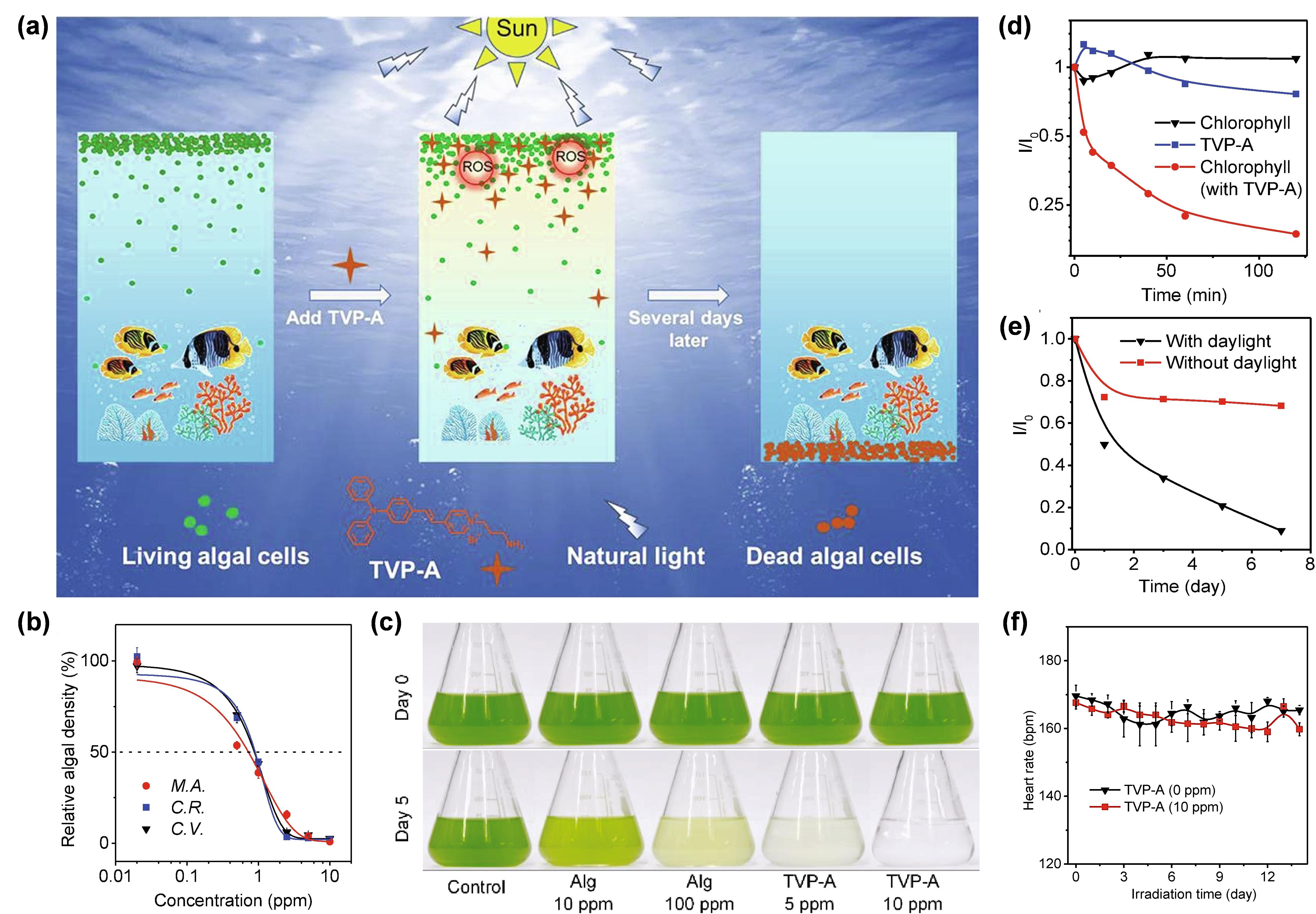
Figure 6. (a) Schematic illustration of selectively removing HAB by TVP-A upon natural light irradiation. (b) Relative cell density of three algae after incubating with TVP-A at different concentrations after 96 h under the simulated daily cycles. M.A.: M. aeruginosa; C.R.: C. reinhardtii; C.V.: C. vulgaris. (c) Photos of C. reinhardtii (1.6 × 107 cells/mL) in the presence of Alg (10 ppm and 100 ppm) or TVP-A (5 ppm and 10 ppm) under the simulated daily cycles on day 0 and day 5. (d) The change of the relative fluorescence intensity (I/I0) in C. reinhardtii (1.6 × 107 cells/mL) in the presence or absence of TVP-A (5 ppm) under different times of simulated natural light illumination. (e) Variation in relative absorbance of TVP-A at 462 nm with or without different natural light for evaluating the degradability of TVP-A. (f) The change of average heart rates of fish with or without TVP-A during the 14 days of cultivation time under the simulated daily cycles. Reprinted with permission from [73], copyright 2021, Elsevier.




